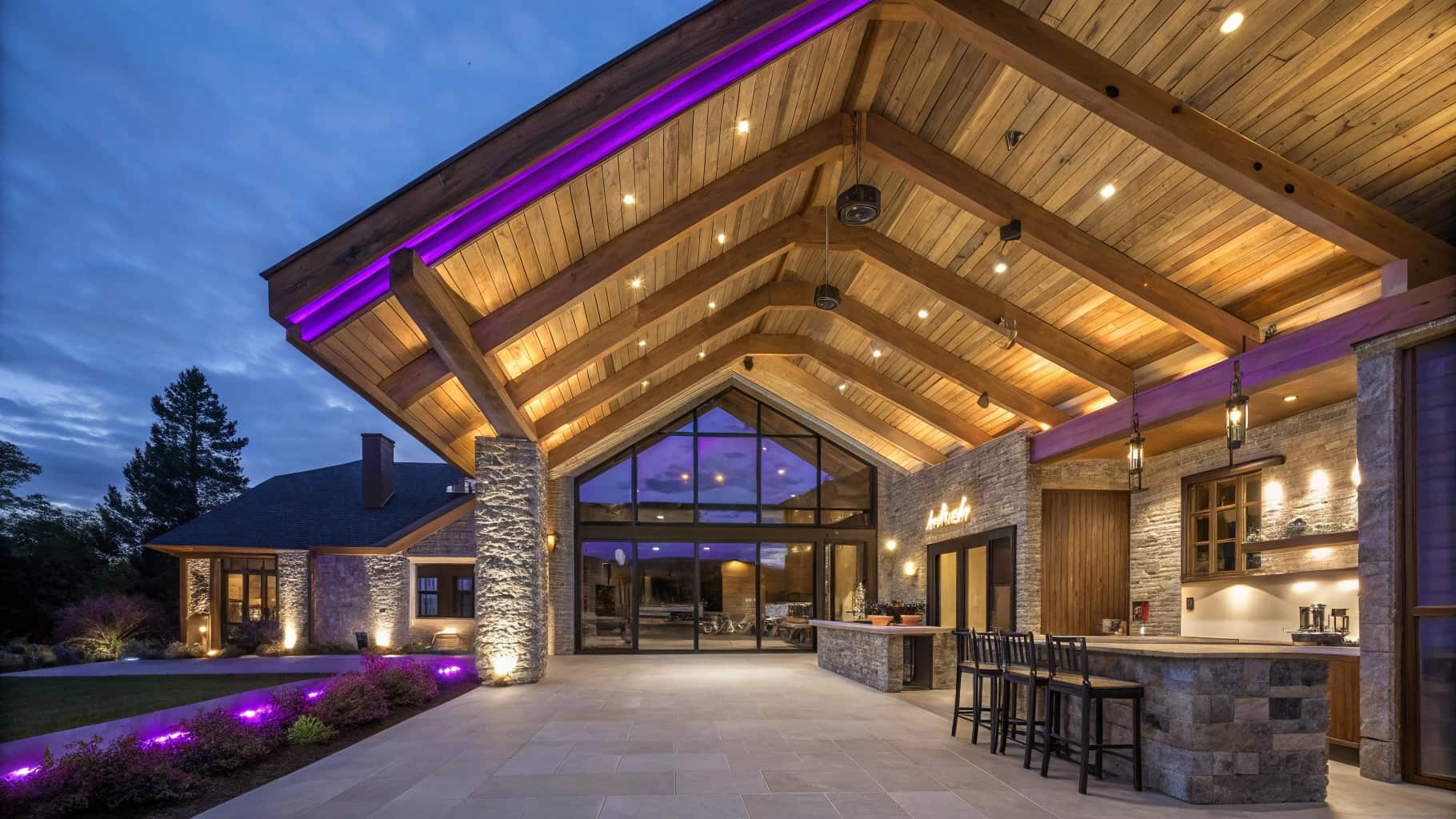The integration of recycled materials into high-end homes has emerged as a significant trend in contemporary architecture and interior design. As the world grapples with the pressing issues of climate change and resource depletion, homeowners and designers alike are increasingly recognizing the value of sustainability. High-end homes, often seen as symbols of luxury and exclusivity, are now being redefined by their commitment to environmental responsibility.
This shift is not merely a passing fad; it reflects a broader cultural movement towards sustainable living, where the aesthetics of luxury harmonize with ecological mindfulness. Recycled materials encompass a wide range of products, from reclaimed wood and recycled glass to repurposed metals and textiles. These materials not only reduce waste but also offer unique characteristics that can enhance the overall design of a home.
The use of recycled materials in high-end homes allows for the creation of spaces that are not only visually stunning but also rich in history and narrative. As architects and designers explore innovative ways to incorporate these materials, they are discovering that sustainability can coexist with sophistication, leading to a new paradigm in luxury living.
Environmental Benefits of Using Recycled Materials
Reducing Waste and Promoting Sustainability
By utilizing recycled materials, builders can significantly decrease waste, contributing to a more sustainable construction process. For instance, reclaimed wood from old barns or factories not only diverts waste from landfills but also reduces the need for new lumber, which can lead to deforestation and habitat destruction.
Energy Efficiency and Lower Emissions
Moreover, the production of recycled materials typically requires less energy compared to their virgin counterparts. For example, recycling aluminum saves up to 95% of the energy needed to produce new aluminum from bauxite ore. This energy savings translates into lower greenhouse gas emissions, making recycled materials a more environmentally friendly choice.
Achieving High Aesthetic Standards while Reducing Environmental Impact
High-end homes that prioritize these materials contribute to a reduction in their carbon footprint, aligning with the growing demand for eco-conscious living. The use of recycled materials thus represents a proactive approach to mitigating environmental impact while still achieving high aesthetic standards.
Economic Benefits of Using Recycled Materials
In addition to their environmental advantages, recycled materials can also offer significant economic benefits for homeowners and builders. The initial cost of sourcing recycled materials may sometimes be lower than that of new materials, particularly when considering items like reclaimed wood or salvaged bricks. These materials often come from local sources, reducing transportation costs and supporting local economies.
Furthermore, as demand for sustainable building practices increases, the market for recycled materials is expanding, leading to more competitive pricing. Investing in recycled materials can also enhance the long-term value of a high-end home. Properties that incorporate sustainable features are increasingly appealing to buyers who prioritize eco-friendliness and energy efficiency.
According to a study by the National Association of Realtors, homes with green certifications or energy-efficient features tend to sell faster and at higher prices than their conventional counterparts. This trend suggests that homeowners who choose to integrate recycled materials into their designs may not only enjoy immediate cost savings but also benefit from increased property value over time.
Aesthetics and Design Considerations
The aesthetic appeal of recycled materials is one of the most compelling reasons for their incorporation into high-end home design. Each piece of reclaimed wood or salvaged metal carries its own unique history and character, adding depth and personality to a space. Designers often find that these materials can serve as focal points or conversation starters within a home.
For instance, a feature wall made from reclaimed barn wood can evoke rustic charm while simultaneously providing a modern twist when paired with sleek furnishings. Moreover, the versatility of recycled materials allows for creative expression in design. Recycled glass can be transformed into stunning countertops or decorative tiles, offering vibrant colors and textures that are difficult to replicate with new materials.
Similarly, repurposed metals can be fashioned into striking light fixtures or architectural details that enhance the overall aesthetic of a home. The ability to blend these materials with contemporary design elements creates a harmonious balance between old and new, resulting in spaces that are both stylish and sustainable.
Durability and Longevity of Recycled Materials
Durability is a critical consideration in high-end home design, and many recycled materials offer exceptional longevity when properly maintained. For example, reclaimed wood is often more resilient than newly harvested lumber due to its age and density. Wood that has weathered years of exposure to the elements tends to be less prone to warping or splitting, making it an ideal choice for flooring or structural elements in a home.
Additionally, many recycled materials have already undergone natural aging processes that enhance their strength and stability. Furthermore, the use of durable recycled materials can lead to lower maintenance costs over time. High-quality recycled products often require less frequent replacement or repair compared to their conventional counterparts.
For instance, recycled rubber roofing systems are known for their longevity and resistance to harsh weather conditions, providing homeowners with peace of mind regarding their investment. By choosing durable recycled materials, homeowners can create spaces that not only look beautiful but also stand the test of time.
Innovation and Uniqueness in High-End Home Design
Unconventional Materials, Unique Designs
For example, some designers have experimented with using recycled shipping containers as structural elements in modern homes, creating striking visual contrasts with conventional building materials. Moreover, the uniqueness of recycled materials means that no two homes will ever be exactly alike. Each piece carries its own story and character, allowing homeowners to express their individuality through their living spaces.
Personalization and Sustainability
This emphasis on personalization resonates with buyers who seek more than just a house; they desire a home that reflects their values and lifestyle choices. As high-end homes increasingly embrace this ethos, the market is likely to see a rise in demand for bespoke designs that prioritize sustainability alongside aesthetic appeal.
The Future of Luxury Living
Case Studies of High-End Homes Using Recycled Materials
Several high-end homes around the world exemplify the successful integration of recycled materials into luxurious designs. One notable example is the “Reclaimed House” in New York City, designed by architect David Baker. This innovative residence features reclaimed wood siding sourced from local barns, giving it a distinctive character while minimizing environmental impact.
The interior showcases repurposed bricks from an old factory, creating an industrial yet warm atmosphere that resonates with urban living. Another inspiring case is the “Green House” in California’s Bay Area, which utilizes salvaged materials throughout its construction. The home features reclaimed steel beams and recycled glass windows that not only enhance its aesthetic appeal but also contribute to its energy efficiency.
The design incorporates passive solar principles and green roofs, demonstrating how recycled materials can be harmoniously integrated into sustainable architecture without compromising luxury.
Future Trends in the Use of Recycled Materials in High-End Homes
As awareness of environmental issues continues to grow, the future of high-end home design will likely see an even greater emphasis on the use of recycled materials. Innovations in technology are making it easier for architects and builders to source high-quality recycled products that meet stringent performance standards while maintaining aesthetic appeal. For instance, advancements in recycling processes are enabling the creation of new composite materials made from post-consumer waste, which can be used in everything from flooring to countertops.
Additionally, as consumers become more educated about sustainability, there will be an increasing demand for transparency regarding material sourcing and environmental impact. Homeowners will seek out builders who prioritize eco-friendly practices and can provide detailed information about the origins of their materials. This trend will likely drive further innovation within the industry as companies strive to meet consumer expectations while maintaining high standards of quality and design.
In conclusion, the integration of recycled materials into high-end homes represents a transformative shift in architectural design that prioritizes sustainability without sacrificing luxury or aesthetics. As this trend continues to evolve, it will undoubtedly shape the future landscape of residential architecture, paving the way for more environmentally responsible living spaces that reflect both individual style and collective values.
FAQs
What are recycled materials?
Recycled materials are items that have been processed and transformed into new products after being used and discarded. These materials can include glass, metal, plastic, paper, and textiles.
Why are recycled materials used in high-end homes?
Recycled materials are used in high-end homes for several reasons, including their sustainability, durability, and unique aesthetic appeal. Using recycled materials also helps reduce the environmental impact of construction and promotes a more eco-friendly lifestyle.
What are some examples of recycled materials used in high-end homes?
Examples of recycled materials used in high-end homes include reclaimed wood for flooring and furniture, recycled glass for countertops and tiles, recycled metal for fixtures and accents, and recycled plastic for outdoor decking and furniture.
How do recycled materials contribute to sustainable living in high-end homes?
Recycled materials contribute to sustainable living in high-end homes by reducing the demand for new resources, minimizing waste, and lowering the carbon footprint of construction and interior design. Using recycled materials also supports the circular economy and promotes responsible consumption.
Are there any challenges associated with using recycled materials in high-end homes?
Some challenges associated with using recycled materials in high-end homes include sourcing high-quality materials, ensuring consistency in appearance and performance, and managing the costs of incorporating recycled materials into luxury designs. However, these challenges can often be overcome with careful planning and collaboration with experienced suppliers and designers.

